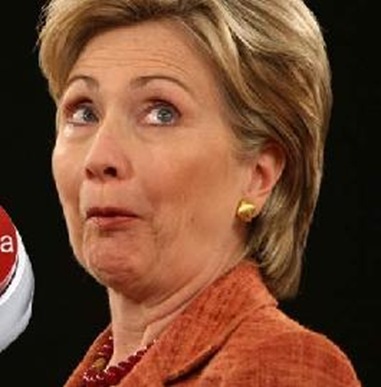This post is obviously related to the film and reading for today although for the most part inspired by Brandi's mentioning of voice in her question.
In my sound class earlier this week, we analyzed Hillary's cracked voice in this video
And how the "cracks" in her voice as well as her voice registers are carefully staged and planned to signify an involuntary vulnerability that somehow implies interiority and veracity. A strategic break from the politician character, if you well, to "show the real person" as just the same as everyone else (who eats pizza and doesn't exercise).
In class, we said that her voice here is a spectacular performance. We also looked at Hillary's cackle and how those moments framed her as losing control and potentially volatile.
Not that I am proposing to separate the sound and the sight, but I find the performances of voice and performances of the face curiously mismatched.
Majority of her public (invariably disseminated around the world) appearance features a somewhat stoic face- with eyes staring directly into the camera, relatively immobile eye brows, and a meticulously calculated smile showing precise amount of teeth while maintaining the rest of the face basically the same. It conveys a sense of composure, and many other politicians have that same face. In the crying video you see that her eye brow raised a little further than usual but if you turn off the sound, her face doesn't really do that much. Same in the cackling clip-- her voice gave away, but her face maintained.
Of course, there are parallel moments of failed facial performances:
In some ways I think the discussion on face parallel's the discussion on voices: they are both thought of as bearing paralinguistic functions and are communicative in a semiotic way, and both are thought of as indexing some sort of veracious interiority. Both seem to have their roots in the involuntary body, so the words can lie but the face or the voice might have no choice but to reveal the truth.
We can critique all we want these ways of thinking about the face (or the voice) in the seminar room, but when Hillary cries or cackles, or when she makes an ugly face and is caught on camera, the signification of her lost-control voices and faces still register. And sometimes the politicians themselves manipulate that seemingly truthful paralinguistic communication power of the faces and the voice (like Hillary's crying or the perpetually composed faces) and some other times media (that disseminates her ugly face) put that same mechanism to work to achieve their goals.
I just realized that this is exactly what Barthe and Sartre are talking about.
But my re
al question has to do with Hilary's well-composed faces when her voices "lose control"-- Does that just reinforce the truthful impression of her voice? As in, "even though she's strong enough to maintain composure on the surface, but inside she's vulnerable," thus creating a selling point that she is a real person, without challenging her politician's composure? Or does it work the opposite way, as in "her face hardly twitched when she talked about something so emotional" and render it unconvincing?
Side note: here are some formulaic Obama faces, and if you browse through Jimmy Fallon's
Obama Facial Expression explained it becomes really obvious how formulaic Obama's politician face is.











